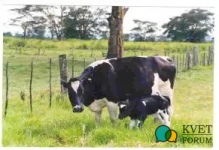Kvet Forum
Administrator
The exact origins of the breed are difficult to determine but it is known that in the 18th century, herds of small black-and-white cattle were brought into northern Holland and Friesland from northern Jutland to replace animals that had fallen victim to disease and flooding. These animals were crossed with the existing Dutch cattle and formed the basis of the Friesian.
Before the establishment of the Netherlands herd book in 1873 and the Friesland herd book in 1879, both black-pied and red-pied animals were maintained separately. The preference for black-pied cattle, particularly in the United States, led to the further segregation of red-pied animals and presently this colour variation only exists in small number in the Netherlands.


Production levels of this breed declined during the 1950's when excessive emphasis was placed on correct colour pattern. During the 1970's Holsteins were imported from the United States and used to improve the milk production. This resulted in larger animals with a more pronounced dairy characteristics. The mixing of these two breeds is such that now many Friesians are 25% to 75% Holstein.
The modern Friesian is pre-eminently a grazing animal, well able to sustain itself over much lactation, on both low lying and upland grassland, being developed by selective breeding over the last 100 years. Some outstanding examples of the breed have 12 to 15 lactations to their credit, emphasizing their inherent natural fecundity. In response to demand, protein percentages have been raised across the breed and herd protein levels of 3.4% to 3.5% are not uncommon.
Typical characteristics include:
Purpose: Milk production
Potential yield: 40-50 litres milk/day, 3.2% butter fat.
Average body size: Large (550-650 kg)
Description: Black and white short haired coat, short horns
Advantages:
Disadvantages:
The farms where they can be found include:
1. Manera (Delamere Estates), Naivasha
2. KARI Naivasha, PO Box 25 Naivasha
3. KAR Lanet, PO Box 1275, Nakuru
4. Agricultural Development Corporation (ADC) Katuke Complex, PO Box 1392-30200 Kitale
5. Makongi Farm, PO Box 1320-30100 Eldoret
6. Kisima Farm, PO Box 19- 20107 Njoro
7. Gogar Farm PO Box 6-201080 Rongai
8. University of Nairobi Farm PO Box 29053-10202 Kabete
9. Sanctuary Farm PO Box 244-20177 Naivasha
10. Marimba Farm PO Box 32 Meru
11. ADC Olngatongo PO Box 680-30200 Kitale
12. Gicheha Farm, PO Box 236 Ruiru
Before the establishment of the Netherlands herd book in 1873 and the Friesland herd book in 1879, both black-pied and red-pied animals were maintained separately. The preference for black-pied cattle, particularly in the United States, led to the further segregation of red-pied animals and presently this colour variation only exists in small number in the Netherlands.
The modern Friesian is pre-eminently a grazing animal, well able to sustain itself over much lactation, on both low lying and upland grassland, being developed by selective breeding over the last 100 years. Some outstanding examples of the breed have 12 to 15 lactations to their credit, emphasizing their inherent natural fecundity. In response to demand, protein percentages have been raised across the breed and herd protein levels of 3.4% to 3.5% are not uncommon.
Typical characteristics include:
Purpose: Milk production
Potential yield: 40-50 litres milk/day, 3.2% butter fat.
Average body size: Large (550-650 kg)
Description: Black and white short haired coat, short horns
Advantages:
- High milk production potential with low butter fat content of about 3.2%
- Note: Milk production will depend on level of feeding and other management. Heifers generally come into milk at about two years of age.
- Suitable for zero grazing
- Frequent calving in their lifetime, longevity, so need less replacements
- Provide valuable male calves
- Have lower cell counts
- They are known for their versatility: they provide high quality milk and high quality lean meat
Disadvantages:
- Heavy feeder
- Need high level management
- Susceptible to diseases, susceptible to milk fever
- Susceptible to high temperatures
- Feed requirements high (90-110 kg fresh forage/day i.e. 3 gunny bags)
- Adequate clean water (min 60 lts/day, more for heavy yielders)
The farms where they can be found include:
1. Manera (Delamere Estates), Naivasha
2. KARI Naivasha, PO Box 25 Naivasha
3. KAR Lanet, PO Box 1275, Nakuru
4. Agricultural Development Corporation (ADC) Katuke Complex, PO Box 1392-30200 Kitale
5. Makongi Farm, PO Box 1320-30100 Eldoret
6. Kisima Farm, PO Box 19- 20107 Njoro
7. Gogar Farm PO Box 6-201080 Rongai
8. University of Nairobi Farm PO Box 29053-10202 Kabete
9. Sanctuary Farm PO Box 244-20177 Naivasha
10. Marimba Farm PO Box 32 Meru
11. ADC Olngatongo PO Box 680-30200 Kitale
12. Gicheha Farm, PO Box 236 Ruiru


